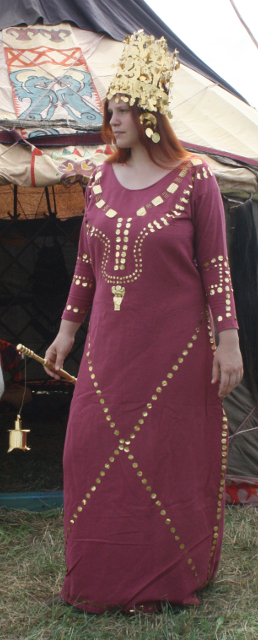The Nomads of Tilla-Tepe
ca. 50 AD
Tillya Tepe is a hill in northern Afghanistan. During excavations in 1978 six graves were found there, which dated to the beginning of the Common Era. The Fund is called “Bactrian Gold” because of the numerous gold objects and was considered to be lost temporarily during the Afghanistan war.
There are many indications that in Tillya Tepe nomadic or former nomads were buried as many finds point out, such as a collapsible and therefore easy to transport crown. Also the jewelery and weapons with the typical animal style found in the graves of Tillya Tepe, indicate the affiliation of the Iron Age steppe dwellers to the cultural complex of Eurasian nomadic horsemen. The deceased may be able to be assigned to the Yuezhi or Saks, which had invaded Bactria and erected the Kushan Empire at the time of building the burial place (50 AD ). Scientists strongly indicate, however, that such a direct allocation in the context of the cultural conglomerate in Bactria is impossible.
The fashion of the upper class, to cover the clothes with countless gold leaf, is also reflected in Tillya Tepe. One found thousands of small separate gold applications which originally adorned coats, shirts and headwear. The former arrangement on cloth hems etc. was used as the basis for the reconstruction of the individual pieces of clothing which is considered similar to the Eurasian nomads due to the similar material culture. The problem with this type of reconstruction, however, is that the tombs were greatly damaged in part and the gold plates were not found in its original location. Presumably, they were distributed by rodents over time on the premises. To date, only reconstruction approaches of Viktor Sarianidi were made, where we got our bearings in terms of the cut of the garments.
The fund postural inaccuracies are hereby acknowledged and therefore our presentation of grave 3 is to be considered only as a approximately one.
In grave 6 lay a woman whose head was adorned with an ornate golden crown. It was foldable and refers to the nomadic origins. On the garment of the dead about 560 gold plaques were sewn. A replica of the dress revealed that it may have served in this form only as a dead garment, since the attachment of the gold plates the everyday use in any form was appropriate, even if it should have acted a ritual garment. Besides the woman lay an object that is nowadays been interpreted as a scepter. The grave goods prove not only the high social position of the person, but also the wide-ranging trade contacts, from which they benefited: in her grave a Chinese silver mirror was found, a Parthian silver coin and two Roman vials.
We used the clothes of the woman, who was buried in grave 3, for a representation of an everyday-use-outfit of this cultural complex. The woman was wearing probably a high cap, which was decorated with an open-worked gold sheet. She was dressed with a hinged coat, a long shirt, breeches and short boots. This equipment refers to the common nomads clothing throughout steppe belt.
Go to the equipment details.
Literature:
Sarianidi, Viktor (Hg.) (1985): L’Or de la Bactriane. Foulles de la Nécropole de Tillia Tépé en Afghanistan septentrional. Léningrad: Éditions d’art Aurora.
Kunst- und Ausstellungshalle der Bundesrepublik Deutschland (Hg.) (2010): Gerettete Schätze aus Afghanistan. Die Sammlung des Nationalmuseums in Kabul. Amsterdam: Production Foundation De Nieuwe Kerk.
Hiebert, Fredrik und Pierre Cambon (Hg.) (2008): Afghanistan. Hidden Treasures from the National Museum, Kabul. Washington D.C.: National Geographic.


